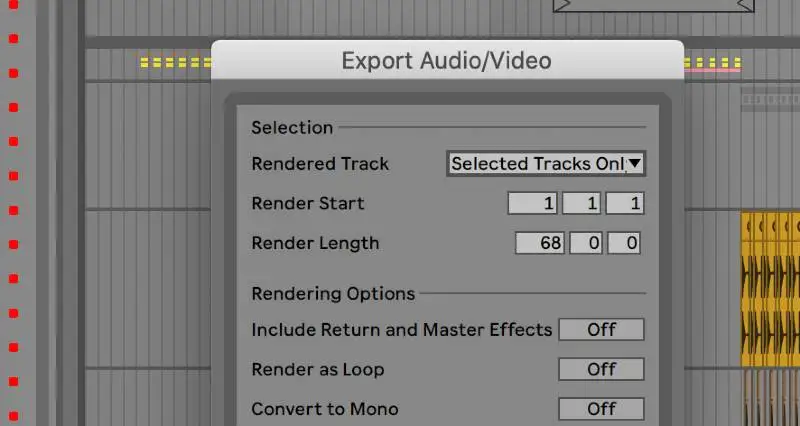Music production jargon can get confusing. That being said, it's important to understand relevant terms commonly used by audio engineers so that you can communicate effectively throughout the music industry.
Today, we'll be decoding one of the most commonly used terms: Music stems or simply "stems". Below, we'll detail what mixing engineers mean when they refer to stem tracks. We'll also dive into how you can create stems from your DAW and explain one of the most common misconceptions surrounding stems.
What are Stems In Music?
The term stems originally comes from film and is used to describe multiple tracks combined into a single audio file. All tracks within a stem relate to one another, for example, a vocal stem might include a lead vocal along with all of the related backing vocals. This is not to be confused with multitracks.
Mutlitracks are individual components that make up a stem. Multiple tracks make up one stem, and multiple stems make up a single song. Stems in music are used for for applications like live performance, stem mastering , and occasionally mixing, though most mixes are processed with individual tracks to give an engineer complete control over the sonic structure of a song.
It's important to note, however, that stems in music are often used colloquially to refer to individual tracks. This is not technically correct, though you may hear musicians toss around the term when they truly mean multitracks. Multitracks can also be referred to simply as a track or "stripes". Stems can also be referenced as a group track.
What are the Benefits of Using Stems?
There's a whole world of creative possibilities when it comes to utilizing stems. Here are some of the benefits for using stems in music.
- Stems offer more control than a final mix on its own. By nature, stems offer more creative possibilities than a final stereo mix on its own. Stems give musicians more aspects to play with while remixing, mixing, or using the stems for live performance.
- Stems group together and organize audio files to speed up the process. If a musician doesn't require each of the audio files for individual drums, having a drum stem can make the process more efficient overall. Stems are convenient and organized.
- Stems can be perfect for certain types of collaborations. DJs and live performance spaces certainly appreciate stems for their ability to provide more sonic control without being overly deconstructed.
Keep in mind that there are some downsides to using stems as opposed to individual tracks. This is because stems do not offer as much creative control as unprocessed audio files. Most mixing engineers will ask for individual tracks rather than "stems" for this reasoning. That being said, those creating an official remix or putting together a set for live performance will likely appreciate the efficiency of stems.
When Should You Use Stems?
So, when should you use stems vs. multitracks ? Essentially, whenever the scenario calls for them. It's essential to communicate effectively with your collaborators to ensure that you're using stems when appropriate vs. individual audio files.
How to Use Stems
Here are a couple of ways in which you might utilize stems as opposed to a full mix or multitracks:
- Certain mixing scenarios-- Different types of mixing may require you to split stereo files into stems rather than each track. For example, a commercial project may ask to fade in the drum stems in a certain way that's different from the full mix.
- For Live Performances-- Stems are incredibly useful for live performance since it allows for the original artist to deconstruct their song for a particular venue without going too granular.
- As a tool for remixes-- Stems are golden tools for DJs and remix creators who need stems to create a recording, but aren't necessarily interested in breaking down or sampling every aspect of a song.
- Stem mastering-- During stem mastering, stems are used to help elevate the final mix . This can sometimes produce a more polished result than traditional mastering.
When Should you NOT use Stems?
There are some scenarios in which you'll want to avoid using stems. Here are some of the most common scenarios where you'll want to use individual files instead of stem groupings.
- When your engineer or collaborator really wants multitracks. Stems and multitracks are not the same thing, though someone may ask for "stems" and really mean individual tracks. In this scenario, you'll want to send individual tracks so that your collaborator has as much control as possible while creating.
- When you're not sure about your processing. One characteristic unique to stems is that they usually have built in sound effects or processing. If you aren't sure how you'd like each of your instruments, vocals, or drums to be mixed, it might be better to send the individual pieces rather than a group file.

Where to Find Stems?
Locating stems can be complicated. By far, the best way to locate stems for an official remix is to contact the original creator. Remember that you cannot sample a song (or its stems for that matter) unless you have explicitly cleared it with the rights holder. Additionally, you can also seek out stems from online remix contests for new music on sites like Splice.
How to Export Stems For Collaboration
So, your engineer has requested stems. Don't panic, we'll give you a step by step plan for how to bounce out stems for music. Be sure to follow each step carefully to ensure that you send out everything properly.
- Clarify with your engineer or collaborator.
- Finalize your tracks.
- Organize as needed.
- Create a folder and export stems.
- Share stems along with BPM, key, and any other necessary details.
1.Clarify with your engineer or collaborator.
It's easy to confuse multitracks with stems, especially since the two terms are used interchangeably in today's world of audio production. Double check with your collaborator to see if he's looking for all the stems or multiple tracks of a composition. Also, ask whether or not he or she is looking for separate stems with processing or without processing. In some cases, they may request both. It's always a good idea to clarify as much as possible before bouncing out individual elements to save time and potentially money when working with a professional studio.
2.Finalize your tracks.
Make sure your tracks and track groupings or stems are exactly to your liking before sending files. The closer you can get your audio components to where you want them to be, the better the final stereo audio file or entire song will be after delivering stems to your engineer.
3.Organize as needed.
Don't send stems as they are. Be sure to clean out any dead space, cut off any audio tails and label tracks accordingly. Even something as simple as "drum stem" is better than nothing at all. An engineer should be able to guess how your group tracks sound just by looking at the name of the stem. Also, make sure to cut out any deactivated tracks to create fewer files for your collaborator to sift through.
4.Create a folder and export stems.
Create a folder to export your stereo recordings to. It's a good idea to title the folder the name of the track, potentially including the BPM. Export or "bounce" the stems to this folder, and then listen back to each of the stereo files to make sure you exported the group tracks correctly.
In Ableton, this equates to exporting "selected tracks only" and only selecting the grouped stem files before clicking export. Alternatively, you can create a separate session, with only the printed stems (or stems consolidated to single audio files) and select export for "all individual tracks".

Other software such as Pro Tools, Cubase, FL Studio, Logic and others all have their own way of exporting stems. Here are quick videos detailing how to export multitracks and stems into some of the most frequently used DAWs .
Pro Tools: https://www.youtube.com/watch?v=6cmcHBs_5wo
Cubase: https://www.youtube.com/watch?v=v4Gd-6aNB8U
FL Studio: https://www.youtube.com/watch?v=RAq1WSpc1hg
Logic: https://www.youtube.com/watch?v=cRSbEM1m3RU
5.Share stems along with BPM, key, and any other necessary details.
Now it's time to share your stems! Make sure you upload your folder to a cloud based service like Dropbox or Google Drive. Share the folder with a private link along with information on the song's BPM and key. You can also share any notes you have on the song including mixing and mastering preferences.
Stem FAQs: What You Need To Know
If you're still struggling to understand stems, here is a quick set of frequently asked questions and answers to build your knowledge.
What is a stem file?
A stem file simply refers to a group of individual files exported into one file. For example, if you had multiple vocal parts, the vocal stem would include all of these parts. A stripe or track refers to the individual audio files that make up a singular stem, yet the terms are often used interchangeably though mistakenly.
Do you need stems to master?
Stems are helpful if you’re engaging in stem mastering or a process in which a mastering engineer uses stem files to elevate and enhance the final mix of a song. Mastering engineers can also process tracks using a single mix file.
How many stems are there in a song?
The amount of stems depends greatly on the complexity of a song. Songs with lots of different parts each with their own intricate layer structure will have more stems than songs with fewer parts. The more tracks you have, the more likely you are to have more stems since many of the tracks are potentially layers to each sonic component.
Where do producers get stems for their music?
Producers can get stems for their music by grouping together relevant tracks and exporting the groupings. It’s not uncommon for DJs to request stems while creating mixes, since the individually processed drum, instrument, and vocal groups can be easier to layer with separate components.
What's the difference between stem up and stem down?
This doesn’t refer to music production stems, instead, this context refers to the stems or lines connected to notes on the musical staff. Stem up notes are above the middle line of the staff and stem down notes are below the middle note of the staff.
Can you mix a song without stems?
You can mix a song without stems. However, you cannot mix without individual tracks. Since the terms are often used interchangeably, it can get confusing - If you’re working with a mixing engineer, most of the time they’ll be asking for multitracks or individual audio files since this will give them the most control over a project.
Does every track need stems?
Not every track needs to be exported as stems, especially if you’re exporting as multitracks or you haven’t added processing yet to your audio file groupings. True stems can be helpful for live performances, remixes, or in certain mixing environments.
How long is a stem in music?
Stems in music could refer to the line of a note on a musical staff or the length of an audio file group in music production. On the musical staff, stems are typically all the same length. In music production, the length depends on the length of the overall track.
Do you need stems to do a remix?
Remixes can be approached in many ways , but having the stems is super helpful if you have access to them. Remixes can also be done by sampling the original track, or utilizing the track’s acapella vocal or vocal stem alone.
What does it mean to bounce stems?
Bouncing stems simply means exporting the audio groupings in order to be prepped for your collaborator or engineer. Before bouncing stems, you should take care to label stems properly and organize them as needed. Also, clarify with your engineer if they’re looking for processed or unprocessed audio groupings.
The terms single track and single stem are often used in place of one another, but hopefully this article clears up any confusion surrounding stems in music. Enjoy printing stems for your future collaborations!





